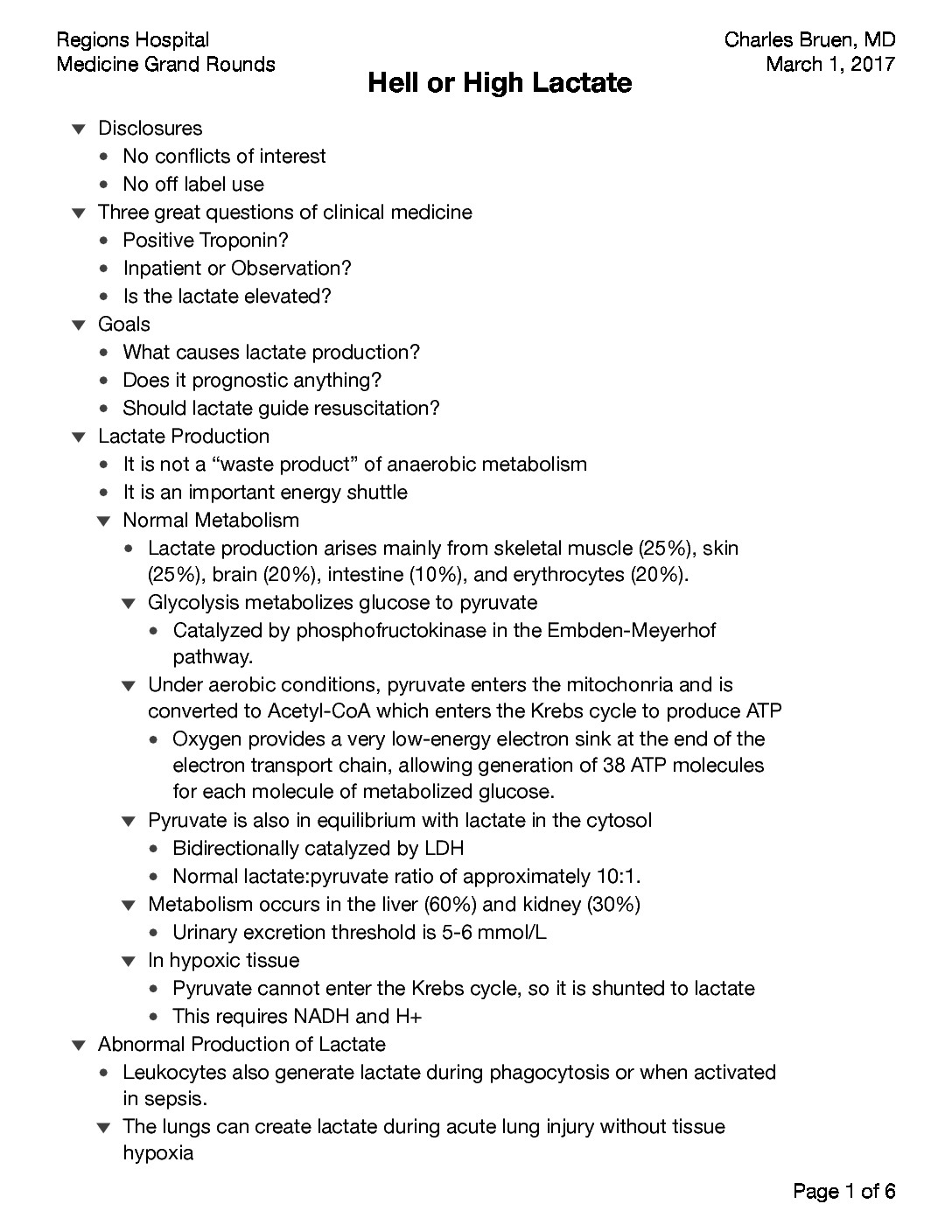Skip to content
Regions Hospital Internal Medicine Grand Rounds (March 1, 2017)Charles Bruen2017-03-03T14:46:39-06:00

Presentation — Hell or High Lactate
| Outline |
|
Presentation |

|
|

|
Selected References (Key Readings)
-
Review Article
- Suetrong B, Walley KR. Chest 2016; 149(1):252-261. Lactic Acidosis in Sepsis: It’s Not All Anaerobic. Implications for Diagnosis and Management.
- Levy, Bruno. Current Opinion in Critical Care 2006, 12:315. Lactate and shock state: the metabolic view.
-
Biochemistry of Lactate Production
- Robergs RA, Ghiasvand F, Parker D. Am J Physiol Regul Integr Comp Physiol 287: R502–R516, 2004. Biochemistry of exercise-induced metabolic acidosis.
- James JH, Luchette FA, McCarter FD, Fischer JE. Lancet 1999;354:505. Lactate is an unreliable indicator of tissue hypoxia in injury or sepsis.
- Lindinger MI, Kowalchuck JM, Heigenhauser GJF. Am J Physiol Regul Integr Comp Physiol 289: R891, 2005. Applying physicochemical principles to skeletal muscle acid-base status.
-
Lactate Measurements
- Lavery RF, Livingston DH, Tortella BJ, Sambol JT, Slomovitz BM, Siegel JH. The utility of venous lactate to triage injured patients in the trauma center. J Am Coll Surg 2000;190:656-64.
- Younger JG, Falk JL, Rothrock SG. Relationship between arterial and peripheral venous lactate levels. Acad Emerg Med 1996;3:730-4.
- Middleton P, Kelly AM, Brown J, Robertson M. Agreement between arterial and central venous values for pH, bicarbonate, base excess, and lactate. Emerg Med J 2006;23:622-4.
- Jones AE, Leonard MM, Hernandez-Nino J, Kline JA. Determination of the effect of in vitro time, temperature, and tourniquet use on whole blood venous point-of-care lactate concentrations. Acad Emerg Med 2007;14:587-91.
-
Lactate Elevation Association with Mortality
- Nichol AD, Egi M, Pettila V, et al. Relative hyperlactatemia and hospital mortality in critically ill
patients: a retrospective multi-centre study. Crit Care 2010;14:R25.
- Mikkelsen ME, Miltiades AN, Gaieski DF, et al. Serum lactate is associated with mortality in severe
sepsis independent of organ failure and shock. Crit Care Med 2009;37:1670-7.
- Mizock BA, Falk JL. Lactic acidosis in critical illness. Crit Care Med 1992;20:80-93.
- Howell MD, Donnino M, Clardy P, Talmor D, Shapiro NI. Occult hypoperfusion and mortality in
patients with suspected infection. Intensive Care Med 2007;33:1892-9.
- Shapiro NI, Howell MD, Talmor D, et al. Serum lactate as a predictor of mortality in emergency
department patients with infection. Ann Emerg Med 2005;45:524-8.
- Cady LD, Jr., Weil MH, Afifi AA, Michaels SF, Liu VY, Shubin H. Quantitation of severity of critical
illness with special reference to blood lactate. Crit Care Med 1973;1:75-80.
- Aduen J, Bernstein WK, Khastgir T, et al. The use and clinical importance of a substrate-specific
electrode for rapid determination of blood lactate concentrations. JAMA 1994;272:1678-85.
-
Lactate Clearance
- Jones AE, Shapiro NI, Trzeciak S, Arnold RC, Claremont HA, Kline JA. Lactate clearance vs central venous oxygen saturation as goals of early sepsis therapy: a randomized clinical trial. JAMA 2010 Feb;303(8):739-46.
- Nathan I. Shapiro, Michael D. Howell, Daniel Talmor, Larry A. Nathanson, Alan Lisbon, Richard E. Wolfe, J. Woodrow Weiss Serum Lactate as a Predictor of Mortality in Emergency Department Patients with Infection . Annals of Emergency Medicine – May 2005 Vol. 45, Issue 5, Pages 524-528.
- Hayes MA, Timmins AC, Yau E, Palazzo M, Hinds CJ, Watson D. Elevation of systemic oxygen delivery in the treatment of critically ill patients. N Engl J Med 1994 Jun;330(24):1717-22.
- Marik PE, Bellomo R, Demla V. Lactate clearance as a target of therapy in sepsis: A flawed paradigm. OA Critical Care 2013 Mar 01;1(1):3.
- Gattinoni L, Brazzi L, Pelosi P, Latini R, Tognoni G, Pesenti A. A trial of goal-oriented hemodynamic therapy in critically ill patients. N Engl J Med 1995 Oct;333(16):1025-32.
- Rivers E, Nguyen B, Havstad S, et al; Early Goal-Directed Therapy Collaborative Group. Early goal-directed therapy in the treatment of severe sepsis and septic shock. N Engl J Med. 2001;345(19):1368-1377
- Nguyen HB, Rivers EP, Knoblich BP, et al. Early lactate clearance is associated with improved outcome
in severe sepsis and septic shock. Crit Care Med 2004;32:1637-42.
- Nguyen HB, Loomba M, Yang JJ, et al. Early lactate clearance is associated with biomarkers of
inflammation, coagulation, apoptosis, organ dysfunction and mortality in severe sepsis and septic shock.
J Inflamm (Lond) 2010;7:6.
- Broder G, Weil MH. Excess Lactate: An Index of Reversibility of Shock in Human Patients. Science
1964;143:1457-9.
- De Backer D. Lactic acidosis. Minerva Anestesiol 2003;69:281-4.
Page load link


